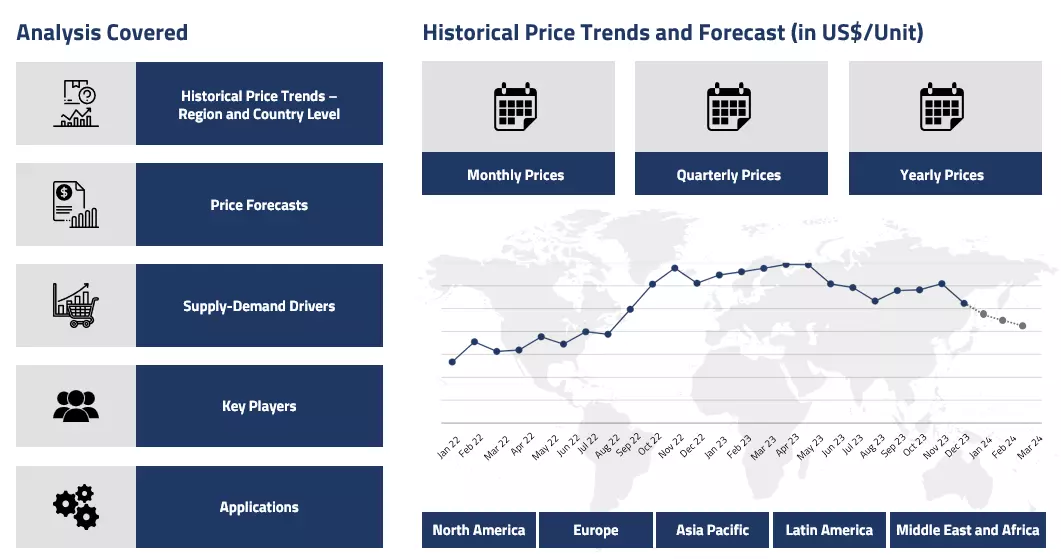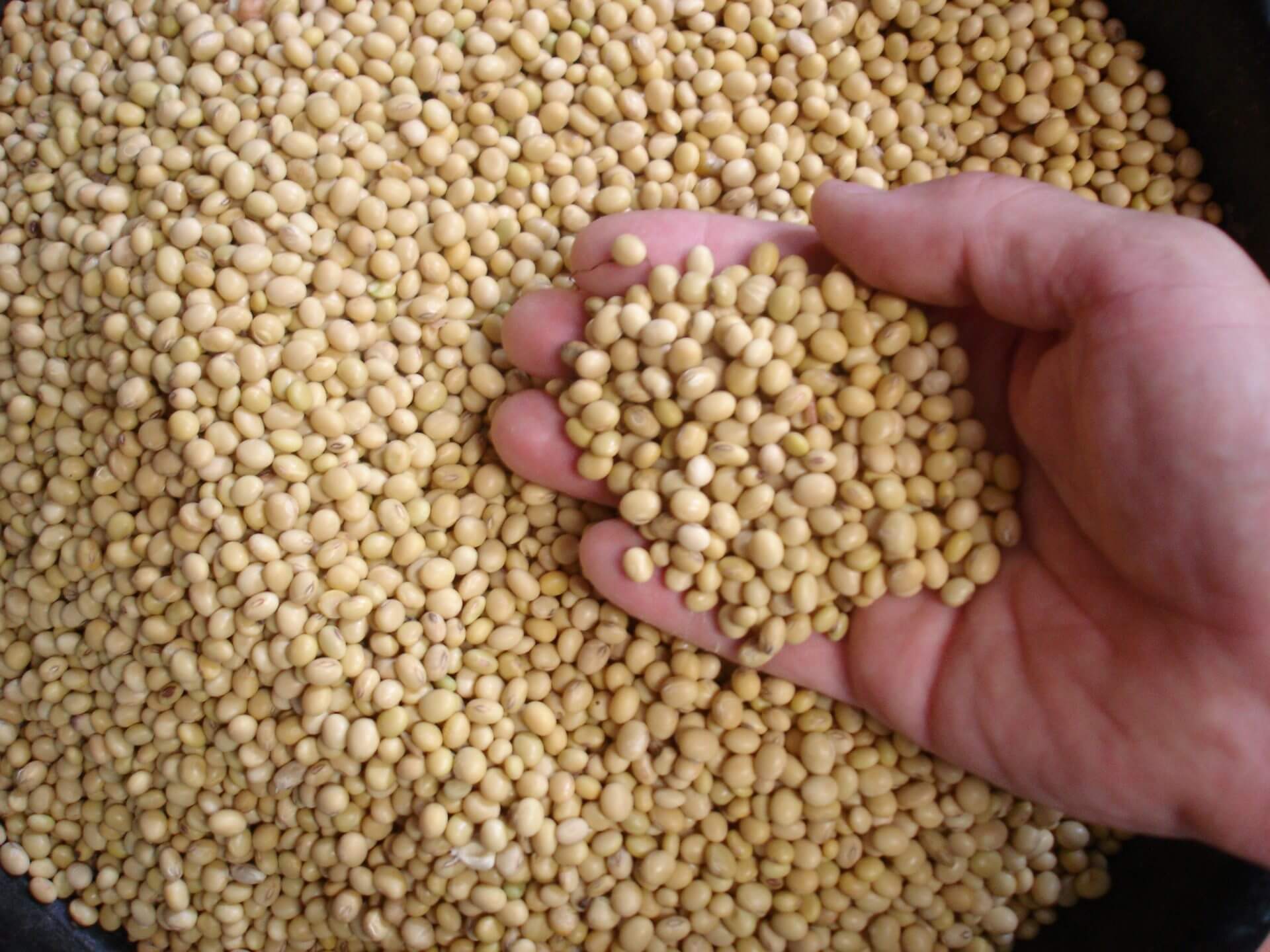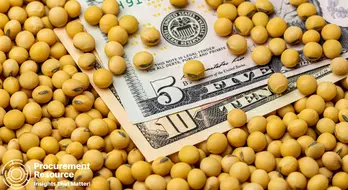Product
Soybean Price Trend and Forecast
Soybean Price Trend and Forecast
Soybean Regional Price Overview
Get the latest insights on price movement and trend analysis of Soyabean in different regions across the world (Asia, Europe, North America, Latin America, and the Middle East & Africa).
Soyabean Price Trend for Q1 of 2025
| Product | Category | Region | Price | Time Period |
| Soybean | Agriculture, Farming and Commodity | China | 566 USD/MT | January 2025 |
| Soybean | Agriculture, Farming and Commodity | China | 575 USD/MT | March 2025 |
| Soybean | Agriculture, Farming and Commodity | Brazilian | 358 USD/MT | January 2025 |
| Soybean | Agriculture, Farming and Commodity | Brazilian | 372 USD/MT | March 2025 |
Stay updated with the latest Soybean prices, historical data, and tailored regional analysis
Asia
The soybean price curve in China remained stable with a slight upward trend during the first quarter of 2024. The monthly average prices were approximately 566 USD/MT in January and 575 USD/MT in March. According to the soybean price database, prices dipped slightly at times but found support as demand from crushing facilities increased.
Soybean Price Chart

Please Login or Subscribe to Access the Soybean Price Chart Data
Overall, prices remained steady with minor upward movement. Meanwhile, China escalated its trade countermeasures against the U.S. by suspending import licenses for three U.S. soybean companies and blocking U.S. log imports. This action coincided with China imposing tariffs on $21 billion worth of U.S. agricultural products, including soybeans, wheat, and meat. The suspensions were reportedly due to phytosanitary concerns, such as pests and contaminants in U.S. shipments.
Europe
Soybean imports into the European Union reached their highest level in a decade, sustaining an upward trend in soybean prices during the first quarter of 2024. According to the soybean price database, strong shipments from Brazil and Argentina helped meet the growing demand.
The soybean price graph indicated that a surplus in global supply, coupled with increased crushing activity in key regions, prevented any sharp price surges while maintaining a gradual upward movement throughout the quarter. Additionally, price analysis suggested that increased soybean meal utilization supported demand, particularly due to restricted supplies of alternative protein meals such as rapeseed and sunflower meal.
Americas
Brazilian soybean prices fluctuated throughout the first quarter of 2024 but generally maintained an upward trend. According to the soybean price database, prices were highly volatile, with periods of decline followed by strong recoveries. The monthly average prices stood at approximately 358 USD/MT (FOB) in January and around 372 USD/MT in March.
The soybean price curve reflected this movement, displaying temporary dips before rebounding. The soybean price graph highlighted strong export demand, particularly from China, as a key factor in driving prices higher. Despite occasional fluctuations, steady buying activity sustained an overall positive market trajectory. The soybean price analysis further indicated that even with price swings, market sentiment remained optimistic, supported by robust export demand and evolving supply conditions.
Analyst Insight
According to Procurement Resource, the soybean price trend is expected to stabilize and fluctuate within a narrow range in the near future, though some regional variations may still occur.
Soybean Price Trend for the First Half of 2024
Asia
China's soybean market in the first half of 2024 was characterized by heightened import activity, primarily from Brazil. Chinese buyers ramped up purchases from Brazil due to the competitive pricing resulting from the weaker Brazilian domestic markets. The country increased its share of Brazilian soybean exports, causing a buildup of soybean inventories at Chinese ports by mid-year.
Concerns over a potential new trade conflict with the United States, depending on the outcome of the US elections, added to the cautious approach of Chinese importers. Consequently, China's preference for Brazilian soybeans contributed to the reduced demand for US soybeans, reinforcing the global price decline observed during this period.
Europe
In Europe, soybean prices during 2024 have generally been on a downward trend, influenced by several global market dynamics. Favorable supply conditions worldwide, including increased production forecasts in major soybean-producing countries like the United States, Brazil, and Argentina, have contributed to the bearish market sentiment. European prices have been further affected by weak export demand and speculative selling in the futures market.
Moreover, recent weather expectations, such as the anticipated rainfall from tropical storms in key growing areas, have led to additional price pressure. While geopolitical factors, such as changes in Brazilian export tax policies, raised concerns about shifting supply sources, the overall impact has not been sufficient to counterbalance the prevailing bearish sentiment. Therefore, the outlook remains subdued, with prices expected to stay lower unless adverse weather conditions or changes in demand dynamics create upward pressure.
South America
In South America, Brazil's soybean market remained robust, driven by strong Chinese demand and favorable exchange rate dynamics. Despite weather challenges, Brazil achieved its second-largest soybean crop in history. The decline of the Brazilian real against the US dollar helped mitigate lower global soybean prices, allowing Brazilian exporters to maintain a competitive edge. This currency advantage facilitated record-high exports to China, with Brazil's overall soybean exports rising in the first half of the year. Meanwhile, Argentina recovered from a previous season's drought, boosting its harvest and contributing to a favorable supply outlook in the region. This increased supply further pressured global soybean prices downward.
Analyst Insight
According to Procurement Resource, the price of Soybean is expected to exhibit a complex interplay of changing global supply patterns, and excessive supply from the majority of the soybean growing nation will likely to keep the prices of the commodity on the lower end.
Soybean Price Trend for the Second Half of 2023
| Product | Category | Region | Price | Time Period |
| Soybean | Agriculture, Farming and Commodity | China | 738 USD/MT | July 2023 |
| Soybean | Agriculture, Farming and Commodity | China | 687 USD/MT | December 2023 |
| Soybean | Agriculture, Farming and Commodity | Brazilian | 477 USD/MT | July 2023 |
| Soybean | Agriculture, Farming and Commodity | Brazilian | 473 USD/MT | December 2023 |
Stay updated with the latest Soybean prices, historical data, and tailored regional analysis
Asia
The soybean prices showcased a tepid trajectory during the second half of the year 2023. The prices were mostly observed to be falling down, particularly in the Chinese market. The monthly average prices in the Chinese soybean market went from about 738 USD/MT in July’23 to around 687 USD/MT in December’23. This caused an approximate 6% decline in the country’s soybean prices over the said span. China noted an incline in production which strengthened the supply outlook for the East Asian nation.
On the other hand, a slight dip in annual soybean production pulled the prices slightly up in the Indian market. Because of the uncertainties around palm oil exports from Indonesia, other edible oils noticed a rise in customer interest, including soybean oil, thereby impacting the prices of soybeans. Hence, with occasional upswings and downswings, soybean prices showcased a hybrid trajectory during the last two quarters of 2023.
Europe
During the given period, the European markets were witnessing a serious supply chain crisis, which only grew more serious as the fourth quarter began. The Panama Canal was already almost choked as the water level declined significantly because of drought-like conditions, so vessel movement was hindered. And on top of that, the number of shipments declined through the Suez Canal also. Israel and Hamas conflict disturbed international trade dynamics, and the Red Sea crisis emerged as a new problem. The Houthi attacks on commercial vessels in the Red Sea forced ships to rethink operations through these waters.
South America
In Southern America, soybean prices were mostly found to be wavering within very confined limits throughout the said period. The region registered a notable growth in soybean production during this time, which kept the domestic market well supplied. In the Brazilian market, the prices went from about 477 USD/MT in July’23 to about 473 USD/MT in December’23. Overall, an almost stable trend was observed.
Analyst Insight
According to Procurement Resource, similar regional variations are anticipated in Soybean prices going forward since the supply and demand dynamics are not projecting much change.
Soybean Price Trend for the First Half of 2023
Asia
Despite the high demand, the price trend for Soybean were mostly tilted downward in the first quarter. As the quarters shifted, the inventory stocks started subsiding, but the agricultural yields were good enough to quickly replenish the gaps. To complement it, regularization in upstream costs via persistent normalization in energy, labor, and freight charges also played its part. A stable both-way exchange had been established in the Soybean market by the middle of the second quarter. A mixed market performance was observed from Soybeans during the discussed time period.
Europe
Given the Black Sea deal, the Ukrainian Soybeans found their way back to the European and global markets. As diverse trade routes were being figured and supply chains were being restored, inflation rates also started coming under check. With the initiation of normalization in energy and power bills, the Soybean prices also started coming down. Overall, a downward wavering price pattern was observed for Soybeans during the concerned period.
North America
The North American Soybean market behaved in a very similar manner to the European Soybean market. The market trend fluctuated within a very limited and narrow range all through the said period. A more or less stable market dynamic was observed.
Analyst Insight
According to Procurement Resource, the unrestricted flow of Soybean supplies suggests a similar market behavior going forward in the coming months.
Soybean Price Trend for the Second Half of 2022
Asia
Asian markets witnessed a mixed price trend for Soybeans during the second half of the year 2022. The first half of the third quarter was relatively slow; however, soon, the market picked pace, and the Soybean prices rose steadily for the rest of the discussed period till the end of the final quarter.
In November 2022, India’s Ministry of Consumer Affairs, Food, and Public Distribution removed the stock limit for edible oil and oil seeds, which led to high-scale stocking of Soybean seeds at the grassroots level. Consequently, a gap was observed in the domestic market supplies, which further fuelled the running prices. Overall, a positive market behavior was observed by Soybean during the said period.
Europe
The European Soybean market struggled badly with high inflation for a long time. With people participating less in purchasing activities, Soybean market demands took a serious hit. Although periodically, prices went up as Soybean is a common food commodity, general market behavior was poor. The black sea deal had further created a supply glut. Overall, mixed price trend were observed.
North America
Varied price trend were witnessed for Soybeans in the North American market during the last two quarters of 2022. As the USA was handling most of the supply issues at the peak of the Russia and Ukraine conflict, Soybean prices soared throughout the third quarter. However, as the supply diversification started, rapid market normalization was observed following mid-Q4.
Analyst Insight
According to Procurement Resource, a stable supply-demand dynamic is expected for Soybeans going forward, so the prices are likely to fluctuate in a narrow range.
Soybean Price Trend For the Second Quarter of 2022
Asia
After the additional imports of 5.5 lakh tons GM soymeal were allowed by the Indian government in order to help the poultry sector, soybean prices fell in the country. The prices eades by 7-8% in May. According to trade sources, soyabean prices dropped by 500-600 INR/quintal in the third week of May in Madhya Pradesh mandis such as Dewas, Vidisha, and Khandwa, among others.
North America
In Q2 of 2022, season-average soybean price for 2022–2023 has been cut from 14.40 USD/bushel (bu) to 14.35 USD/bu.
Europe
Italian soybean prices averaged 662 EUR/MT in the second quarter of 2022.
Veneto has approximately 135 thousand hectares of soybean cultivation in Italy, followed by Friuli-Venezia Giulia, which has over 54 thousand hectares. This widespread use of soybeans is mostly due to low production costs and high sales costs, as well as the fact that cultivating soybeans disrupts cereal succession and enriches the ground.
Soybean Price Trend For the First Quarter of 2022
Asia
In China, soybean outright prices reached 757.73 USD/MT in March 2022 increasing by 3% on a week-to-week basis and 10% on a month-to-month basis. The increase in soybean prices were a result of high freight costs amid low supplies. China bought 55-60 cargos which tightened the freight situation in the region. Active demand from Chinese buyers set the CFR China basis on rally mode amid rising Chicago Board of Trade futures.
North America
In the January, the soybean futures price in the US rose to more than 15 USD/bushel, the highest since June 2021, as production in Brazil was severely affected by drought-like conditions. According to reports from USDA, the soybean yield is estimated to drop by 3% to approximately 3.44 tonnes per hectare.
Latin America
In Brazil, the soybean crops were affected by the drought which brought down the production in 2022 and caused supply disruptions on a global level with the country being a major producer of the commodity. Production estimates of soybean dropped to lower than 120 million tonnes in January 2022 as compared to the 138 million tonnes of production in the previous year. Soybean prices also increased as a result of increasing demand for soybean oil in the global market.
Soybean Price Trend For the Fourth Quarter of 2021
Asia
Soybean prices in India continued to decrease from the high value of 47,000 INR/MT in May to 41000 INR/MT in September, which was quite stable during the months of October and November with slight fluctuations. In China, soybean prices continued to decrease during the fourth quarter from 4140 RMB/MT to 3520 RMB/MT.
Europe
After a decline in soybean prices during the month of September, the prices continue to rise for the fourth quarter from a value of 474.28 during September to 481.83 euros per metric ton during November. Soy’s increasing role in providing a sustainable protein supply in Europe will further increase its demand. Austria, Belgium, Italy, France, the Netherlands, Spain, Greece are some of the major producers to soy in Europe including several CEE countries.
North America
After its peak in May, reaching a high of 643 USD/MT, soybean prices started to decrease, reaching a value of 550.65 USD/MT. The major reason behind it was the delayed and slow pace of China soybean crush and growing stocks which also raised questions about the sustainability of the US exports to China.
Latin America
After a decline in year-high prices during May (3410 BRL/MT), they were quite stable with some fluctuations. In the fourth quarter, the price stood around 3010 BRL /MT.
Soybean Price Trend For First, Second and Third Quarters of 2021
Asia
The domestic soybean prices continued to rise, with the pricing of 4,000 RMB/MT, the highest in 8 years. At the beginning of August, the average market price of soybean meal was 3,700 RMB/MT, while it rose to 3,958 RMB/MT towards month end. Hence, an increase of 6.97% in prices was observed.
According to the USDA, global soybean production was expected to rise by 6% to 386 MMT in 2021-22 mainly because of the larger crop sizes in the United States and India. The MSP for soyabean from September-December 2021 was 526USD/MT whereas the overall domestic prices in India ranged between 706-892 USD/MT.
Europe
The price in Europe drastically increased from 325 EUR/MT in July 2020 to a year high of 473.12 EUR/MT. The price increased continuously (520 EUR/MT as of May 2021) as the demand for the products rose sharply.
North America
According to the USDA's forecasts, the United States was anticipated to produce 120.4 MMT of beans in 2021-2022, representing an almost 5% year-on-year rise and making the current marketing year output the greatest since 2018-2019. At the same time, South America was predicted to produce the greatest crop in history, with Brazil harvesting roughly 144 million tonnes of beans and Argentina harvesting an additional 49.5 million tonnes.
An increase of financial flows connected to rising global inflation pushed commodity prices even more in 2021. Because of anticipated increases in supply, soybean prices slightly decreased from multi-year highs, beginning in June 2021. By the quarter end, the prices observed were close to 576.3 USD/MT
Latin America
The South American industry, notably the Brazilian market, being the world's largest producer and exporter of soybeans, plays an important role in the global soybean market and its pricing.
The marketing year 2020-21 (September–August) US soybean inspection for exports was predicted at 55.7 MMT, up from 34 MMT last year, with the majority of volumes headed for China. According to the Brazilian Foreign Trade Department, the country shipped 33 MMT of beans from January to April, representing a 3.5% rise year on year.
The highest price observed during this quarter was 3410 BRL/MT which declined to 3040 BRL/MT and then closely fluctuated during the entire quarter.
Soybean Price Trend For the Year 2020
Asia
China's annual soybean imports have more than doubled in the recent decade, with an import of approximately a million metric tonnes for 2019-2020 (USDA) accounting for 87% of total Asian imports of 115 million tonnes. Overall, China accounts for more than 60% of global soybean commerce, any increase in Chinese oilseed imports is likely to support world soybean prices. China imported 28.63 million mt of soybeans in the first quarter of 2021, mostly keeping prices flat.
The importance of China in soybean trade cannot be neglected and having the knowledge and understanding of the role that source and product form plays in determining demand is of particular importance to exporters in the United States, Brazil, and Argentina as they continuously try to increase their share of the Chinese market.
Despite of growing demand, the estimated supply for China was stable, and the wholesale price was 4,275 ($657.7) to 4,475 RMB/MT.
Domestically produced soybean prices in India decreased drastically from 95 INR/kg to 60-55 INR/kg after the government permitted the import of 12 lakh tonnes of genetically modified soymeal in August.
Europe
Soybean prices declined slightly during the first two quarters from 348 to 324 EUR/MT post which they increased continuously for the whole year, attaining its peak at the end with a price of 420 EUR/MT.
North America
In 2021, prices hit their highest level since 2012 at 16.06 USD/Bu (bushel), continuing a sharp climb that began in mid-2020 and continued to rise substantially in the first half of 2021 from 8.7 USD/Bu to 14.37 USD/Bu. Since the second quarter of 2020, prices had been bolstered by monetary policies proposed by the US Federal Reserve and other central banks around the world to mitigate the economic shock produced by the Covid-19 pandemic.
Latin America
The prices in Brazil showed a similar trend in terms of continuous increase from Jan 2020 to Nov 2020 ranging from 1610 BRL/MT to 2720 BRL/MT with a slight decrease in prices during the year end, where the price stood at 2620 BRL/MT.
Procurement Resource provides latest prices of Soybean. Each price database is tied to a user-friendly graphing tool dating back to 2014, which provides a range of functionalities: configuration of price series over user defined time period; comparison of product movements across countries; customisation of price currencies and unit; extraction of price data as excel files to be used offline.
About Soybean
The soybean or soya bean is a legume species native to East Asia. These beans are extensively grown for its edible bean, which has numerous uses. One of the conventional unfermented food uses of soybeans include soy milk, from which tofu and tofu skin are made.
Soybean Product Details
| Report Features | Details |
| Product Name | Soybean |
| Industrial Uses | Dairy Products, Dishes, Sauces, Adhesives, Paper Coating Agent |
| Synonyms | Soya bean, Glycine max, Dolichos soja L., Glycine angustifolia Miq. |
| Supplier Database | Cargill, Incorporated, Archer Daniels Midland Company (ADM), Grain Millers, Inc, Corteva Agriscience |
| Region/Countries Covered | Asia Pacific: China, India, Indonesia, Pakistan, Bangladesh, Japan, Philippines, Vietnam, Iran, Thailand, South Korea, Iraq, Saudi Arabia, Malaysia, Nepal, Taiwan, Sri Lanka, UAE, Israel, Hongkong, Singapore, Oman, Kuwait, Qatar, Australia, and New Zealand Europe: Germany, France, United Kingdom, Italy, Spain, Russia, Turkey, Netherlands, Poland, Sweden, Belgium, Austria, Ireland Switzerland, Norway, Denmark, Romania, Finland, Czech Republic, Portugal and Greece North America: United States and Canada Latin America: Brazil, Mexico, Argentina, Columbia, Chile, Ecuador, and Peru Africa: South Africa, Nigeria, Egypt, Algeria, Morocco |
| Currency | US$ (Data can also be provided in local currency) |
| Supplier Database Availability | Yes |
| Customization Scope | The report can be customized as per the requirements of the customer |
| Post-Sale Analyst Support | 360-degree analyst support after report delivery |
Note: Our supplier search experts can assist your procurement teams in compiling and validating a list of suppliers indicating they have products, services, and capabilities that meet your company's needs.
Soybean Production Process
- Production of Soybean via Cultivation.
Soybean is sowed by farmers. For this, seed drillers or a plough can also be utilised. It takes them about 3-5 months to be ready for harvesting.
Methodology
The displayed pricing data is derived through weighted average purchase price, including contract and spot transactions at the specified locations unless otherwise stated. The information provided comes from the compilation and processing of commercial data officially reported for each nation (i.e. government agencies, external trade bodies, and industry publications).
Assistance from Experts
Procurement Resource is a one-stop solution for businesses aiming at the best industry insights and market evaluation in the arena of procurement. Our team of market leaders covers all the facets of procurement strategies with its holistic industry reports, extensive production cost and pre-feasibility insights, and price trends dynamics impacting the cost trajectories of the plethora of products encompassing various industries. With the best analysis of the market trends and comprehensive consulting in light of the best strategic footstep, Procurement Resource got all that it takes.
Client's Satisfaction
Procurement Resource has made a mark for itself in terms of its rigorous assistance to its clientele. Our experienced panel of experts leave no stone unturned in ensuring the expertise at every step of our clients' strategic procurement journey. Our prompt assistance, prudential analysis, and pragmatic tactics considering the best procurement move for industries are all that sets us apart. We at Procurement Resource value our clients, which our clients vouch for.
Assured Quality
Expertise, judiciousness, and expedience are the crucial aspects of our modus operandi at Procurement Resource. Quality is non-negotiable, and we don't compromise on that. Our best-in-class solutions, elaborative consulting substantiated by exhaustive evaluation, and fool-proof reports have led us to come this far, making us the ‘numero uno' in the domain of procurement. Be it exclusive qualitative research or assiduous quantitative research methodologies, our high quality of work is what our clients swear by.
Related News
Table Of Contents
Our Clients

Get in Touch With Us

UNITED STATES
Phone:+1 307 363 1045

INDIA
Phone: +91 8850629517

UNITED KINGDOM
Phone: +44 7537 171117
Email: sales@procurementresource.com





